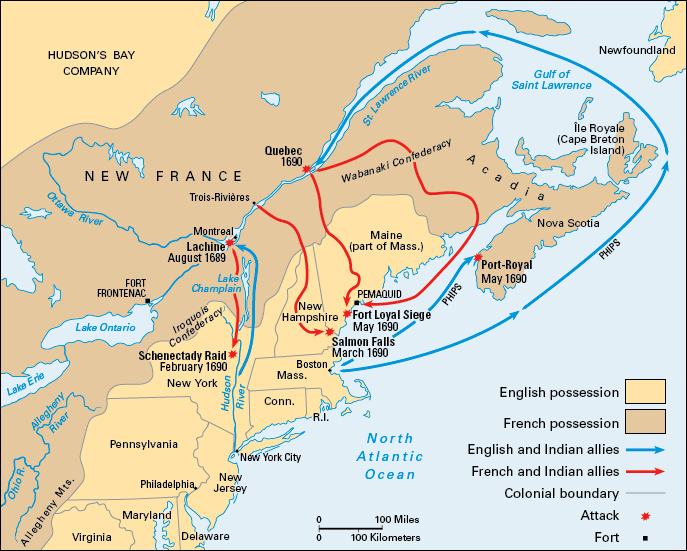King William’s War (1689-1697) was a conflict between the French and British in North America. Named for King William III of England, it was the first of four wars that became known as the French and Indian wars. Much of the war centered in New York, where Indigenous (native) American allies of the English had been challenging French control over the fur trade. The hostilities soon spread to New England and eastern Canada.
Background.
During the late 1600’s, the French claimed much of what is now Canada, the Great Lakes region, and the Mississippi River Valley. They called their North American lands New France. English colonies prospered along the Atlantic coast, from New England to Carolina.

The French and their Indigenous allies dominated the fur trade around the Great Lakes. The powerful nations of the Haudenosaunee (Iroquois) Confederacy, however, dominated much of the land to the east. These nations—which included the Mohawk, Oneida, Onondaga, Cayuga, and Seneca—generally favored the English over the French.
During the 1680’s, New York’s English governor sent traders to the Michigan region—territory claimed by France—to exchange goods for furs. The English also encouraged the Iroquois to disrupt French trading activities. In response, French military expeditions targeted the Seneca in western New York. As tensions grew, Iroquois war parties raided French settlements on the Canadian frontier.
In 1689, England joined with other European powers to confront French expansion under King Louis XIV. The conflict in Europe—known as the War of the League of Augsburg—soon spread to North America.
The war.
In August 1689, an Iroquois force destroyed the Canadian settlement of Lachine, near Montreal. In early 1690, French fighters and French-allied Indigenous fighters—under orders from Governor General Comte de Frontenac of New France—conducted a series of raids. One group marched south from Montreal and assaulted the settlement at Schenectady, New York, in February. Another group attacked Salmon Falls, New Hampshire, in March. In May, French and Indigenous forces besieged Fort Loyal (present-day Portland, Maine) on Casco Bay. Many of the Indigenous people fighting as allies of the French were members of the Wabanaki Confederacy. Raids between the Wabanaki and the New England colonies had been increasing in the late 1680’s.
English militia (citizen army) forces mainly from Connecticut, Massachusetts, and New York soon assembled for retaliation. In May 1690, English colonial forces led by Boston ship captain Sir William Phips captured Port-Royal in what is now Nova Scotia, Canada. Later that year, Phips led Massachusetts forces in a failed assault against Quebec, New France’s capital.
Border raids continued on both sides for the next several years. Iroquois warriors attacked French Canadian settlements, and English colonial militia harassed French frontier posts. French colonial forces and allied Indigenous fighters attacked English settlements in New York and New England, as well as Iroquois villages in New York. In 1696, French-allied forces captured an English fort at Pemaquid in Maine. New England militia retaliated by striking at French settlements in Acadia, a region in eastern Canada. In 1696 and 1697, French forces attacked the English fishing settlements on the coast of Newfoundland. They burned down the port town of St. John’s. English and French forces also fought for control of trading posts in the Hudson Bay area.
The war’s end.
The war between the French and English ended with the signing of the Treaty of Ryswick in 1697. Fighting between the Wabanaki and the New England colonies ended in 1699. The 1701 signing of the Great Peace of Montreal ended the French war with the Haudenosaunee, who pledged neutrality in future Anglo-French conflicts. Hostilities between the French and English colonists in the region arose again in 1703, when the French and allied Indigenous groups conducted raids against New England at the start of Queen Anne’s War (1702-1713).
